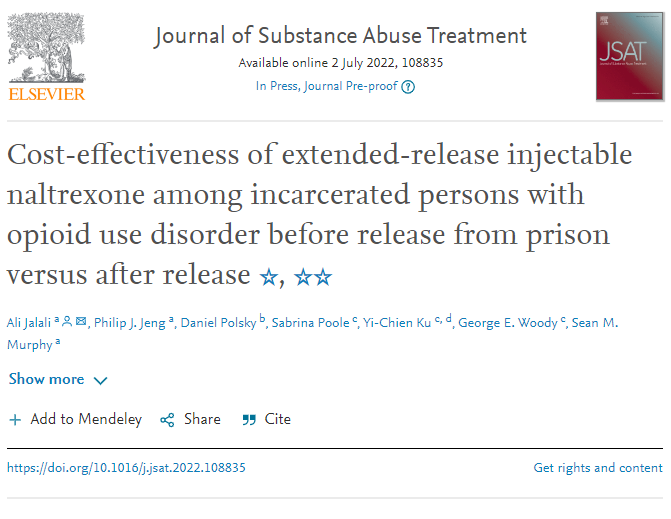Researcher Yi-Chien Ku, along with Assistant Professor Jalali of Cornell University Medical College and Professor George E. Woody of the Department of Psychiatry at Penn State University, published an addiction research article in the Journal of Substance Abuse Treatment
- Publication Date:
- Last updated:2022-07-12
- View count:608
Abstract
Introduction
Opioid use disorder (OUD) is highly prevalent among incarcerated populations, and the risk of fatal overdose following release from prison is substantial. Despite efficacy, few correctional facilities provide evidence-based addiction treatment. Extended-release injectable naltrexone (XR-NTX) administered prior to release from incarceration may improve health and economic outcomes.
Methods
We conducted an economic evaluation alongside a randomized controlled trial testing the effectiveness of XR-NTX before release from prison (n = 38) vs. XR-NTX referral after release (n = 48) of incarcerated participants with OUD, both groups continuing treatment at a community addiction treatment center. The incremental cost-effectiveness ratio (ICER) assessed the cost-effectiveness of XR-NTX before release compared to referral after release for three stakeholder perspectives at 12- and 24-week periods: state policymaker, health care sector, and societal. Effectiveness measures included quality-adjusted life-years (QALYs) and abstinent years from opioids. In addition, we categorized resources as OUD-related and non-OUD-related medical care, state transfers payments, and other societal costs (productivity, criminal justice resources, etc.).
Results
Results showed an association between XR-NTX and greater OUD-related costs and total costs from the state policymaker perspective. QALYs gained were positive but statistically insignificant between arms; however, results showed XR-NTX had an estimated 15.5 more days of opioid abstinence over 24 weeks and statistically significant at a 95 % confidence level based on the distribution of bootstrapped samples. We found that estimated ICERs to be > $500,000 per QALY for all stakeholder perspectives. For the abstinent-year effectiveness measure, we found XR-NTX before release to be cost-effective at a 95 % confidence level for willingness-to-pay values >$49,000 per abstinent-year, across all perspectives.
Conclusions
XR-NTX administered to persons who are incarcerated with OUD before release may provide value for stakeholders and bridge a well-known treatment gap for this vulnerable population. Lower than expected participant engagement and missing data limit our results, and study outcomes may be sensitive to methods that address missing data if replicated.
Abbreviations
OUD
opioid use disorder
XR-NTX
extended-release injectable naltrexone
QALYs
quality-adjusted life-years
HRQoL
health-related quality of life
TLFB
Time Line Follow Back
DATCAP
Drug Abuse Treatment Cost Analysis Program
ICER
incremental cost- effectiveness ratio
CEAC
cost-effectiveness acceptability curve
Keywords
Cost-effectiveness
Opioid use disorder
Criminal justice
Health econometrics
Naltrexone
Medications for opioid use disorder


